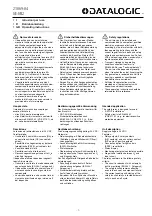
monitoring for loss of field voltage or current. For
generators that are paralleled to a power system,
the preferred method is to monitor for loss of
field at the generator terminals. When a genera-
tor loses excitation power, it appears to the
system as an inductive load, and the machine
begins to absorb a large amount of VARs. Loss
of field may be detected by monitoring for VAR
flow or apparent impedance at the generator
terminals.
The power diagram (P-Q plane) of Fig. 18 shows
the Basler BE1-GPS100 and BE1-40Q character-
istic with a representative setting, a representa-
tive generator thermal capability curve, and an
example of the trajectory following a loss of
excitation. The first quadrant of the diagram
applies for lagging power factor operation
(generator supplies VARs). The trajectory starts
at point A and moves into the leading power
factor zone (4th quadrant) and can readily
exceed the thermal capability of the unit. A trip
delay of about 0.2-0.3 seconds is recommended
to prevent unwanted operation due to other
transient conditions. A second high speed trip
zone might be included for severe
underexcitation conditions.
FIGURE 18. FOR LOSS OF FIELD THE POWER
TRAJECTORY MOVES FROM POINT A INTO THE
FOURTH QUADRANT.
When impedance relaying is used to sense loss
of excitation, the trip zone typically is marked by
a mho circle centered about the X axis, offset
from the R axis by X'd/2. Two zones sometimes
are used: a high speed zone and a time delayed
zone.
FIG. 19. LOSS OF EXCITATION USING IMPEDANCE
RELAY.
With complete loss of excitation, the unit will
eventually operate as an induction generator with
a positive slip. Because the unit is running above
synchronous speed, excessive currents can flow
in the rotor, resulting in overheating of elements
not designed for such conditions. This heating
cannot be detected by thermal relay 49, which is
used to detect stator overloads.
Rotor thermal capability can also be exceeded for
a partial reduction in excitation due to an operator
error or regulator malfunction. If a unit is initially
generating reactive power and then draws reactive
power upon loss of excitation, the reactive swings
can significantly depress the voltage. In addition,
the voltage will oscillate and adversely impact
sensitive loads. If the unit is large compared to
the external reactive sources, system instability
can result.
Thermal Protection
Fig. 20 shows the Basler MPS200, BE3-49R, or
BE1-49 relay connected to a resistance-tempera-
ture detector, embedded in a stator slot. Relay
models are available for either copper or platinum
RTDs. The relay provides a constant-current
source to produce a voltage across the RTD and
includes the means to measure that voltage
(proportional to temperature) using separate leads.
The relays have trip and alarm set points, and the
MPS200 can provide readout of present tempera-
ture.
11
Содержание BE1-1051
Страница 1: ...GeneratorProtection ApplicationGuide...














































